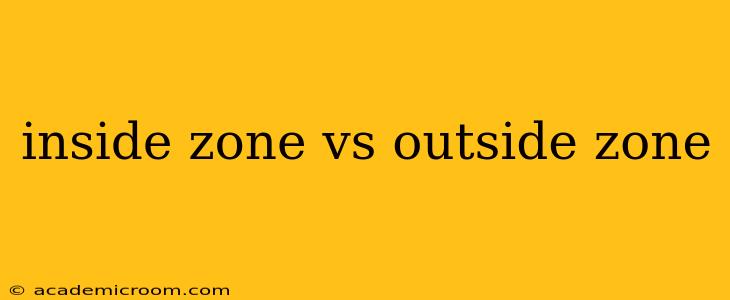In the world of football, understanding offensive strategies is crucial for both players and fans. Two fundamental running plays, the inside zone and the outside zone, form the bedrock of many successful rushing attacks. While both aim to gain yardage, they differ significantly in their blocking schemes, player assignments, and overall effectiveness depending on the defensive alignment. This comprehensive guide will dissect the nuances of each play, helping you grasp their strategic advantages and disadvantages.
What is the Inside Zone?
The inside zone run is characterized by its emphasis on attacking the gaps between the defensive tackles and guards. The offensive line's blocking scheme focuses on reaching the second level (linebackers) to create running lanes. The running back typically follows a predetermined path, aiming for the area between the defensive tackles.
Key Characteristics of the Inside Zone:
- Blocking Scheme: The offensive line uses zone blocking, where each lineman is responsible for blocking the defender immediately in front of them and then working to the second level. This allows for flexibility based on the defensive front.
- Running Back Path: The back generally aims for the inside gaps, often following the flow of the offensive line. The exact path depends on the defensive reaction.
- Best Against: Defenses with less penetration from defensive tackles and linebackers. It can be effective against both even and odd fronts.
What is the Outside Zone?
The outside zone run focuses on gaining yardage outside the tackles. The blocking scheme differs significantly from the inside zone, emphasizing a wider, more horizontal movement by the offensive line. The running back aims for the perimeter, looking for creases to exploit.
Key Characteristics of the Outside Zone:
- Blocking Scheme: Offensive linemen "zone block" by reaching for the defender across from them, sealing off the edge. This often involves a cut block or wash-block by the tackle.
- Running Back Path: The back flows laterally, reading the defensive line and searching for openings on the outside. They often utilize a "bounce" technique, depending on defensive reactions.
- Best Against: Defenses with stronger interior defensive linemen but weaker edge rushers. The wide attack allows the running back to exploit the space.
Inside Zone vs. Outside Zone: Key Differences Summarized
| Feature | Inside Zone | Outside Zone |
|---|---|---|
| Target Gap | Between guards and tackles | Outside the tackles |
| Blocking Focus | Second level (linebackers) | Perimeter (edge defenders) |
| Back's Path | Primarily inside | Primarily outside, laterally |
| Defensive Weakness Exploited | Weak interior run defense | Weak edge containment |
| Ideal Defensive Alignment | Balanced front seven | Strong interior line, weak edges |
What are the advantages of the inside zone?
The inside zone can be highly effective against defenses that struggle to penetrate the offensive line. By focusing on second-level blocking, it aims to create holes beyond the initial defensive line, leading to larger gains. Its effectiveness stems from its adaptability; the offensive line can adjust blocking assignments based on the defense's response.
What are the advantages of the outside zone?
The outside zone excels when defenses have strong interior defensive linemen but weaker edge defenders. It allows the offense to spread out the defense horizontally, stretching their linebackers and creating opportunities on the outside. The emphasis on perimeter blocking creates a significant advantage if the defense cannot contain the run at the edge.
Which play is better?
There's no single "better" play. The optimal choice depends heavily on the specific game situation, the opposing defense, and the offensive team's personnel and strengths. A well-rounded offense will utilize both, mixing and matching to keep the defense guessing and capitalizing on their vulnerabilities. Successful play-calling involves understanding these nuances and exploiting the weaknesses presented by the opposing team's defensive alignment.
How do defenses defend against inside and outside zone runs?
Defenses employ a variety of techniques to counter both plays. Against the inside zone, strong penetration from defensive tackles and linebackers is crucial to disrupt the running back's path. Defensive alignment and gap integrity are essential to minimizing gains. To stop the outside zone, edge defenders must maintain contain, preventing the running back from getting to the perimeter. Strong defensive line play is key to limiting the play's effectiveness.
This in-depth analysis provides a foundation for understanding the complexities of these two core running plays. By analyzing game film and recognizing the subtle differences, you can develop a deeper appreciation for the strategic elements of offensive football.
